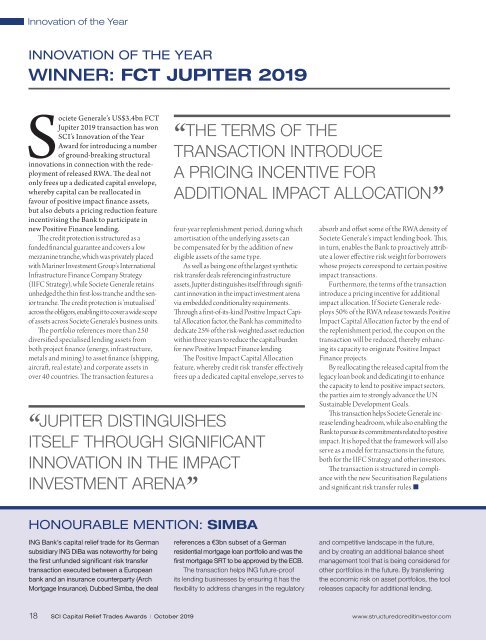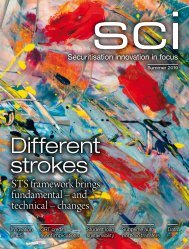SCI CRT Awards Issue Oct 19
Create successful ePaper yourself
Turn your PDF publications into a flip-book with our unique Google optimized e-Paper software.
Innovation of the Year<br />
INNOVATION OF THE YEAR<br />
WINNER: FCT JUPITER 20<strong>19</strong><br />
Societe Generale’s US$3.4bn FCT<br />
Jupiter 20<strong>19</strong> transaction has won<br />
<strong>SCI</strong>’s Innovation of the Year<br />
Award for introducing a number<br />
of ground-breaking structural<br />
innovations in connection with the redeployment<br />
of released RWA. The deal not<br />
only frees up a dedicated capital envelope,<br />
whereby capital can be reallocated in<br />
favour of positive impact finance assets,<br />
but also debuts a pricing reduction feature<br />
incentivising the Bank to participate in<br />
new Positive Finance lending.<br />
The credit protection is structured as a<br />
funded financial guarantee and covers a low<br />
mezzanine tranche, which was privately placed<br />
with Mariner Investment Group’s International<br />
Infrastructure Finance Company Strategy<br />
(IIFC Strategy), while Societe Generale retains<br />
unhedged the thin first-loss tranche and the senior<br />
tranche. The credit protection is ‘mutualised’<br />
across the obligors, enabling it to cover a wide scope<br />
of assets across Societe Generale’s business units.<br />
The portfolio references more than 250<br />
diversified specialised lending assets from<br />
both project finance (energy, infrastructure,<br />
metals and mining) to asset finance (shipping,<br />
aircraft, real estate) and corporate assets in<br />
over 40 countries. The transaction features a<br />
“<br />
THE TERMS OF THE<br />
TRANSACTION INTRODUCE<br />
A PRICING INCENTIVE FOR<br />
ADDITIONAL IMPACT ALLOCATION<br />
”<br />
four-year replenishment period, during which<br />
amortisation of the underlying assets can<br />
be compensated for by the addition of new<br />
eligible assets of the same type.<br />
As well as being one of the largest synthetic<br />
risk transfer deals referencing infrastructure<br />
assets, Jupiter distinguishes itself through significant<br />
innovation in the impact investment arena<br />
via embedded conditionality requirements.<br />
Through a first-of-its-kind Positive Impact Capital<br />
Allocation factor, the Bank has committed to<br />
dedicate 25% of the risk-weighted asset reduction<br />
within three years to reduce the capital burden<br />
for new Positive Impact Finance lending.<br />
The Positive Impact Capital Allocation<br />
feature, whereby credit risk transfer effectively<br />
frees up a dedicated capital envelope, serves to<br />
“<br />
JUPITER DISTINGUISHES<br />
ITSELF THROUGH SIGNIFICANT<br />
INNOVATION IN THE IMPACT<br />
INVESTMENT ARENA<br />
”<br />
absorb and offset some of the RWA density of<br />
Societe Generale’s impact lending book. This,<br />
in turn, enables the Bank to proactively attribute<br />
a lower effective risk weight for borrowers<br />
whose projects correspond to certain positive<br />
impact transactions.<br />
Furthermore, the terms of the transaction<br />
introduce a pricing incentive for additional<br />
impact allocation. If Societe Generale redeploys<br />
50% of the RWA release towards Positive<br />
Impact Capital Allocation factor by the end of<br />
the replenishment period, the coupon on the<br />
transaction will be reduced, thereby enhancing<br />
its capacity to originate Positive Impact<br />
Finance projects.<br />
By reallocating the released capital from the<br />
legacy loan book and dedicating it to enhance<br />
the capacity to lend to positive impact sectors,<br />
the parties aim to strongly advance the UN<br />
Sustainable Development Goals.<br />
This transaction helps Societe Generale increase<br />
lending headroom, while also enabling the<br />
Bank to pursue its commitments related to posit ive<br />
impact. It is hoped that the framework will also<br />
serve as a model for transactions in the future,<br />
both for the IIFC Strategy and other investors.<br />
The transaction is structured in compliance<br />
with the new Securitisation Regulations<br />
and significant risk transfer rules.<br />
HONOURABLE MENTION: SIMBA<br />
ING Bank’s capital relief trade for its German<br />
subsidiary ING DiBa was noteworthy for being<br />
the first unfunded significant risk transfer<br />
transaction executed between a European<br />
bank and an insurance counterparty (Arch<br />
Mortgage Insurance). Dubbed Simba, the deal<br />
references a €3bn subset of a German<br />
residential mortgage loan portfolio and was the<br />
first mortgage SRT to be approved by the ECB.<br />
The transaction helps ING future-proof<br />
its lending businesses by ensuring it has the<br />
flexibility to address changes in the regulatory<br />
and competitive landscape in the future,<br />
and by creating an additional balance sheet<br />
management tool that is being considered for<br />
other portfolios in the future. By transferring<br />
the economic risk on asset portfolios, the tool<br />
releases capacity for additional lending.<br />
18 <strong>SCI</strong> Capital Relief Trades <strong>Awards</strong> | <strong>Oct</strong>ober 20<strong>19</strong> www.structuredcreditinvestor.com




